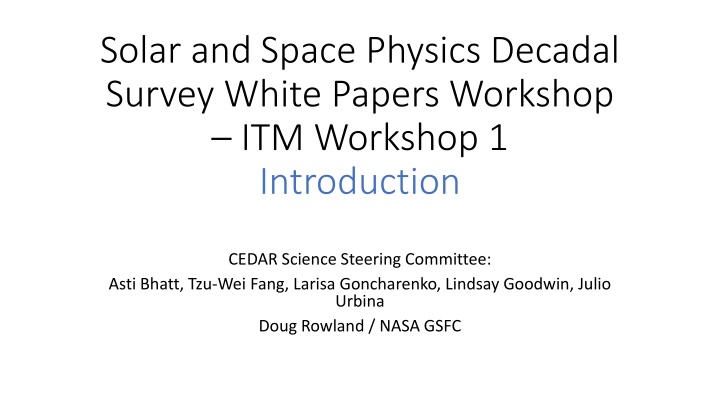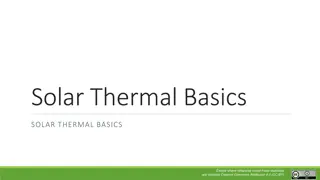Solar and Space Physics Decadal Survey White Papers Workshop: ITM Workshop
The workshop aims to coordinate the ITM community's response to the Decadal Survey's call for white papers. White papers are crucial for scientific, technical, programmatic, and workforce development interests. The workshop format includes initial coordination, planning, and logistics to facilitate detailed discussions on potential topics and authorship for white papers. Follow-up workshops will delve deeper into identified topics, with a focus on generating and completing white papers for submission by the March deadline.
Download Presentation

Please find below an Image/Link to download the presentation.
The content on the website is provided AS IS for your information and personal use only. It may not be sold, licensed, or shared on other websites without obtaining consent from the author.If you encounter any issues during the download, it is possible that the publisher has removed the file from their server.
You are allowed to download the files provided on this website for personal or commercial use, subject to the condition that they are used lawfully. All files are the property of their respective owners.
The content on the website is provided AS IS for your information and personal use only. It may not be sold, licensed, or shared on other websites without obtaining consent from the author.
E N D
Presentation Transcript
Solar and Space Physics Decadal Survey White Papers Workshop ITM Workshop 1 Introduction CEDAR Science Steering Committee: Asti Bhatt, Tzu-Wei Fang, Larisa Goncharenko, Lindsay Goodwin, Julio Urbina Doug Rowland / NASA GSFC
Purpose of workshop To coordinate ITM (and in particular CEDAR) community response to the Decadal Survey call for white papers White papers are expected to be due in March 2022 White papers have no minimum length, though a maximum length is expected White papers can have one author, a few authors, or many authors It is the expectation that ALL white papers will be read and considered by the Decadal Survey panel It is VERY important to write white papers covering areas of scientific, technical, programmatic, and workforce development interest NASA treats the Decadal Survey very seriously and uses it as direct input to planning (not everything in the Decadal Survey gets implemented, but if it isn t in the Decadal, it s not likely to get implemented) NSF and NOAA take the Decadal Survey very seriously as well, though each agency utilizes it in their planning differently. Duplication of white papers on important topics is OK (and can be desirable, if different perspectives on the same topic are provided) What we are trying to avoid is letting major topics fall through the cracks because people think someone else will write that white paper
Workshop format Today s meeting --- initial coordination / planning / logistics Google Form solicited input on potential topics Broad session topics were set up in response We ll have a session with facilitated open discussion about these topics Purpose of today: Identify topics that could form basis for further more detailed discussions in workshops 2, 3 Where possible identify topics that could be the subject of white papers Where possible identify authors and co-authors for white papers After today: Workshops 2 and 3 will dive more deeply into topics of interest to the CEDAR and larger ITM community, with more opportunities to coordinate white papers and co-author teams Follow-up ad hoc meetings among the white paper teams to generate and complete white papers ready for submission to Decadal Survey by March deadline Workshop 2 and 3 dates TBD probably first week of December, and late Jan / early Feb.
Rules of the road This is a meeting for brainstorming and coordination. Ideas generated in our first hour of discussion can be further elaborated in the follow on sessions which have more specific focus In addition to the standard CEDAR policies and codes of conduct, we would like to ask that people provide ideas in a positive and constructive manner. The purpose of this meeting is to coordinate white paper authorships. If you don t agree with a white paper, either submit your comments to the author, or write your own white paper presenting an alternate view. Modes of interaction: Comment on the Google Doc (moderators can edit, all can comment) Raise your hands in RingCentral if you d like to speak We will use CEDAR Slack channel as a parallel mode for sending information You can also put comments in the RingCentral chat, or in Slack.
A possible unifying theme: Cross-scale coupling as a focus for the next decade Cross-scale coupling (loosely defined) can potentially serve as a unifying theme for the next set of Decadal recommendations. This can have broad implications for science topics as well as approaches (ground-based and satellite observations, as well as theory / modeling approaches). Combined ground-based observations and satellite / suborbital measurements, in particular, may be well suited to studying this. Examples: Gravity waves (tens to hundreds of km) are filtered by mean flow (global scale), but also deposit momentum to change the mean flow Small-scale auroral features are set up in the context of large scale electrodynamics, but can produce heating, ionization, and motions that affect the heating, electrodynamics, etc on larger scales GW / Tide / PW interaction over a host of scales this coupling is bidirectional and complex Turbulence and ionospheric instability formation (hundreds or thousands of km scales down to the meter to centimeter scale) What is needed: New observational techniques /approaches that can measure at multiple scales simultaneously New modeling techniques that can address challenges in multi-scale physics This approach will likely have strong overlap with recommendations in the magnetosphere community and potentially solar/heliosphere as well.























